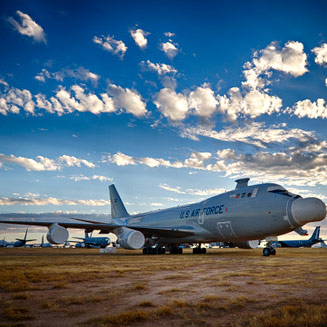Month: November 2012
A Warning to Aerospace Marketing Professionals About Copyright Infringement
![CopyrightStamp_45323893 [Converted].eps](http://66.147.244.184/~bdnaeros/wp-content/uploads/2014/02/copyrightstamp_350-300x262.jpg) Does the end justify the means? Too often, in the world of aerospace marketing, the answer is yes. And that’s not a good thing.
Does the end justify the means? Too often, in the world of aerospace marketing, the answer is yes. And that’s not a good thing.
In their zeal to be noticed and remembered, some marketing people are willing to bend the rules, and, worse, break the law, in regard to intellectual property.
Sometimes it’s ignorance. Not everyone has a marketing background. Some came from the military. Others are engineers.
Case in point. Military marketers at a major OEM wanted to use the song “Bad Moon Rising” in a product video. They just didn’t want to pay for it. So they got permission to use the song once, then proceeded to break all the terms of the agreement, making copies, showing it to groups, and violating copyright laws left and right.
Photo usage is even more problematic, as there is a stubborn resistance to pay for photography and sometimes outright refusal to respect the usage rights for same.
Copyright infringement is a crime that impacts the livelihood of designers, authors, composers, songwriters, and filmmakers. Frankly, it’s theft. And we’re better than this.
Aerospace is a special industry full of good professional people who have integrity and most of us genuinely want to do the right thing. Here’s a reliable resource for more information: copyright.gov
Some More Things We Know About Aerospace Marketing
![Aerospace head_65223433 [Converted].eps](http://66.147.244.184/~bdnaeros/wp-content/uploads/2014/02/aerospacehead_350-300x212.jpg) We know that aerospace companies are conservative and tend to copy one another in their marketing efforts. Everyone’s logo is red, white and blue. Everyone has a Skunk Works, or a Phantom Works, or a Hawk Works. Use this to your advantage and distinguish yourself from the crowd of lookalikes.
We know that aerospace companies are conservative and tend to copy one another in their marketing efforts. Everyone’s logo is red, white and blue. Everyone has a Skunk Works, or a Phantom Works, or a Hawk Works. Use this to your advantage and distinguish yourself from the crowd of lookalikes.
We know that lots of Aerospace and Defense companies do not have a Crisis Communications plan and are completely unprepared should an incident or accident occur. The ramifications could be devastating.
We know that lots of aerospace and defense companies are spending money on ad placements in unaudited magazines that won’t do them any good. If you don’t know exactly who is receiving a given publication, you should not be advertising there.
We know that not everyone in our industry believes in marketing and that some think it’s a necessary evil. We also know that the business that finds itself immune to the necessity of marketing sooner or later finds itself immune to business.
Some Things We Know About Aerospace Marketing
 We know that it’s not unusual for aerospace and defense companies to have a “if we build it, they will come” mentality. That may have been true at one time, but today there are too many providers, and technology is changing too quickly, to make that assumption. It’s not enough to have good technology. You must be prepared to tell the marketplace why your technology is better and what it can do for the customer.
We know that it’s not unusual for aerospace and defense companies to have a “if we build it, they will come” mentality. That may have been true at one time, but today there are too many providers, and technology is changing too quickly, to make that assumption. It’s not enough to have good technology. You must be prepared to tell the marketplace why your technology is better and what it can do for the customer.
We understand that million- and billion-dollar aerospace and defense sales take years to cultivate, and that’s one reason a powerful, enduring brand is so critically important to this market.
We know that there’s a leadership gap in the American aerospace industry. We can make a case for why you should fill it and what that could mean to your company.
We know that engineers are not marketing people. And marketing people are not engineers. We know that marketing people shouldn’t design airplanes and engineers shouldn’t design ads.
We know it’s more important to show your products and technology than it is to talk about them. In person is best. Video demonstration is the second choice. If you have to choose between advertising and demonstrations, you’ve got to go with the demo.
Over to you. What do you know about aerospace marketing?
Marketing Tips: How Large Does A Logo Need To Be?
![]() Anyone in our business hears this request a lot. There’s even a song parody devoted to this very subject: www.youtube.com/watch?v=2fwV-dI0DxM
Anyone in our business hears this request a lot. There’s even a song parody devoted to this very subject: www.youtube.com/watch?v=2fwV-dI0DxM
Why is this so common? Sometimes when clients look at designs, they are focused on the things that are important to them, or what they think will be important to their bosses, like the logo. It’s understandable that they want their branding to be emphasized, but it’s more important to consider the viewpoint of their customers and prospective customers. It’s not about what you care about that matters. What do your customers care about?
Prospects really want to know what you do and what’s in it for them if they do business with you. Everything else is secondary. This is why your messages should first focus on the things that are important to them, and follow-up with information about the company. A larger logo may actually be distracting, and is a dead giveaway that you are a small company or have a small company mentality.
One more thing: Consider how a smaller logo may enhance your brand. Do you want to project an image of refined professionalism and quiet confidence? As the undisputed experts in your field, you don’t need to scream your message — you can quietly and confidently state your case.
Why Paying for Photography Rights Matters
 Photographers are weird.
Photographers are weird.
I mean, they want to get paid for their work. What’s up with that? They’re a nervy bunch, all high and mighty about their talent and their rights and whatnot. Geez.
OK, seriously. For some reason, a lot of aerospace marketing people don’t think they should have to compensate photographers for their work — and that’s just wrong. In our business, it’s a big red warning flag when people brag that they never pay for the photography they use for marketing purposes.
Professional photographers have the knowledge and the skill to make you, your company and your products look your best. From our standpoint, the right photo can make or break a project. Professional photographers are in business, and as a business, need to make a profit.
I just don’t understand those who think otherwise, do you?
Creating 1 image from 7: A Photography How-To
 Because the Boeing 747 that housed the airborne laser (ABL) had a beautiful sunset to back it up, a special technique was used to retain fine detail throughout the shot. The difference in light levels between the clouds and shaded aircraft is too great for a camera to capture, or a computer screen to show, but there is a solution.
Because the Boeing 747 that housed the airborne laser (ABL) had a beautiful sunset to back it up, a special technique was used to retain fine detail throughout the shot. The difference in light levels between the clouds and shaded aircraft is too great for a camera to capture, or a computer screen to show, but there is a solution.
I mounted the camera on a stable tripod and captured seven images of the aircraft without moving. The seven images differed only in the length of time that light was allowed onto the camera sensor.
One image was as the camera’s metering system tried to produce a “normal” photo. However, because those light levels were so disparate, only a poor compromise was possible. Some parts of the image might have been alright, but the brightest and darkest areas were unusable. The brightest parts were pure white, without detail or color, and the darkest areas were pure black.
One of the seven images would have let in much, much more light. The result? The bright areas were even more white and featureless, the entire sky and much of the airplane was were almost completely blank. But the darkest areas would show actual detail and color. Another image would let in a bit less light than that, so the darkest areas were a bit darker, but the lightest areas were starting to reappear. And a third image let in a bit less light, but still a bit more than the “normal” photo.
Conversely, one image let in much, much less light, so that the dark areas were larger, with more of the image plunged into blackness. However, the clouds and sky had rich color and plenty of detail. Another image let in a bit more light, and the last image let in a bit more. The filmstrip illustrates the seven images in the order I’ve described.
The result was seven exposures that, in one or another, have color and detail in every part of the scene. But how do you make one from seven?
For this photo, I prepared the original camera files using DxO Optics Pro to “process” the files, allowing me to work with images that have consistent noise reduction, sharpening, and color correction. Then I combined the seven processed images using a Photoshop plug-in called HDR Efex Pro 2 from Nik Software and made adjustments to brightness, colors and other parameters to arrive at the final photo.
The point of all that was to compress the range of light levels in a way that appears natural and attractive. I know I succeeded because the Business Affairs Office was thrilled with it, and the image was also chosen to run in the base newspaper.
This technique worked for me — you may want to change things up. My exposures differed by a single f-stop. I could have made the differences greater or smaller. I could have processed the camera files differently, using different software and techniques. Other software can be used for combining the seven images. And for that matter, more or fewer images could be captured to create the final.
What was important was the vision to see an opportunity and doing the work to make it a reality.

Aerospace Marketing Tips: Advertising and ROI
November 1, 2012 – As Andy Rooney might have said, “Have you ever noticed how some ad reps claim to know what is best for your clients? And how what is best is always advertising in their magazine?” Or they claim a superior ROI, though they have not a whit of evidence to back it up, and no real way to generate that evidence?
ROI is especially difficult to measure, since while the costs of an ad and its display might be captured, identifying the actual income, that magical “return” on the investment, is almost hopelessly beyond the ability of any company and their agency. At least in B2B. You would need to connect the purchase of a component or a fleet to the costs of creating and running the ad, and then ascribe only the appropriate share of responsibility for the sale as separate from the efforts (and associated expenses) of sales people and public relations and trade shows and direct mail and web sites and on and on.
Aerospace is not a realm of snap purchase decisions, which means influencing those decisions must occur over a span of time and with a strategic, integrated, campaign across multiple channels. Despite some reps’ desire to convince me that theirs is the only place to advertise, and I should move money from other publications (or e-newsletters or web sites) to buy their product, it’s only Jet A smoke and polished aluminum mirrors.






